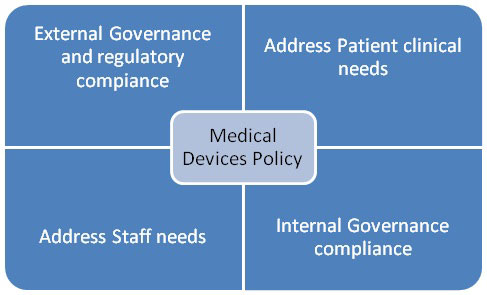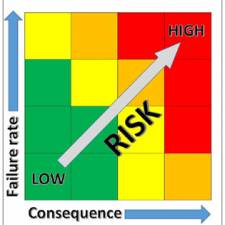Part 2 - Factor impacting on the medical devices policy
The Medical devices policy is important to the organisation to ensure selection, use, and maintenance of all devices is carried out to meet the clinical needs of the patient, but must also meet the external regulatory demands. 'Example' Hospitals NHS Trust must address the staff needs for required device types for their professional practice demands, and the internal governance demands to ensure safe practice and policy compliance as shown below in figure 4.
Figure 4 - Internal NHS Trust demands
 The regulations concentrate on the use and maintenance of medical devices. In my experience, improved procurement delivers cost savings, but is also the KEY to improving training, governance, and maintenance practices. Therefore, the trust medical devices management policy must include procurement practices, if the trust is serious about meeting its regulatory goals.
The regulations concentrate on the use and maintenance of medical devices. In my experience, improved procurement delivers cost savings, but is also the KEY to improving training, governance, and maintenance practices. Therefore, the trust medical devices management policy must include procurement practices, if the trust is serious about meeting its regulatory goals.
Good procurement of medical technology can reduce the size of the inventory, reducing the value of the inventory, and thereby reduce the annual spend on replacing assets. It can also result in improved utilisation of the assets, resulting in improved outcomes for patients, and improved throughput of patients, resulting in improved revenues for the trust.
The procurement of medical technology has an impact on the organisation in terms of cost, availability, and suitability, and strategic needs.
When I was contracted to work at the trust, there were approximately 600 technology groups in use. As an illustration, I will focus on one technology group - Infusion devices.
When I arrived at the trust, there were 18 different models of infusion devices across the trust, with an inventory size of approximately 500 devices for this technology group. An infusion device is used to pump drugs or fluids into the veins of patients. These devices were being bought by Ward or Department managers at local level when they needed one. This type of procurement did not allow for economy of scale or standardisation, with devices being purchased at list price, or limited discounts due to low volumes. Infusion devices were also being given to the trust by charities, and charitable individuals.
The net result is was an increase in cost and risk, because each time an infusion device is used there is a single use plastic tube required to connect the pump to the patient, and every plastic tube is different for every pump. These plastic tube is vary in price, and they can only be used for the infusion pump there were manufactured to connect to.
There were also inefficiencies in nursing time being wasted: for example, If you are a nurse on a Ward, you could go to a cupboard and waste time looking for a pump that you have been trained to use, and waste further time looking for the right plastic tube that fits in that pump. The trust uses 200,000 tube sets each year. The trust was spending £700,000 a year on these tubes. Many of the pumps were old and required replacing, but the current policy on purchasing infusion devices did not allow for bulk buying. I worked with the procurement department and the infusion device users to find a device that was suitable for all staff to use. I replaced all 500 infusion pumps in the trust within one year, with 400 more modern infusion devices that have more functionality and used cheaper tube sets. The 200,000 new tube sets had an annual cost of £200,000, resulting in a £500,000 saving per year on consumable costs. The cost of buying the infusion pumps was £400,000. There was a 20% reduction in the number of devices, and a net 'in year saving' in year one of £100,000, with an overall saving over the 7 year life of these devices of £3.1Million.
Good management of training can results in better use of the assets, reducing the risk of misuse on patients, and improving outcomes for patients. The use of medical technology has a major impact on the business of the trust and the outcomes for patients.
Training is an emotive subject at the trust because staff feel they do not have enough time to be trained on the wide variety of medical technology available to them.
In illustration 1, procurement of infusion devices, I started out at the trust with 18 different models of infusion devices, and reduced this down to three different models of infusion device. These three models were required for clinical reasons and could not be reduced any further. When these infusion devices were purchased, they were introduced into the organisation in a phased approach, ensuring that all users were trained and competent to use the devices before there were placed on the Ward. The old infusion devices were then removed and disposed of in accordance with the trust policy.
The training benefits of moving from 18 different models of infusion device to 3 different models of infusion device were: I had less manufacturers that I had to work with to organise training, and the manufacturers involved were much more willing to come in to the organisation on a more regular basis because they had a larger installed base of their devices at the trust. This allowed me to more easily deliver training to the users, whilst also developing a better relationship with the suppliers. The end goal was to ensure that users of infusion devices could use them safely for the benefit of the patient. I was able to organise and deliver training across the whole organisation over a three-month period on the three new models of infusion devices. To do this level of training on 18 different models of device would have taken me six times longer.
Training is considered a high risk by government, and as a result of this they have introduced the regulations previously discussed. Policymakers at a government level may not understand the practical difficulties of implementing training across 600 technology groups, especially when there was limited standardisation across many of the technology groups in use.
Maintenance of medical technology is important to the efficient running of the organisation, aiding therapeutic and diagnostic care of patients, and also to the volume of equipment required by the organisation.
In illustrations 1 and 2, I talked about procurement and training of infusion devices, and the impact this had on cost and the safe use of this technology group. Maintenance of infusion devices requires holding spare parts and special tools for the devices. The more often technician works on an infusion device, the more experience and expertise that technician builds up in repairing and maintaining that infusion device. Reducing the volume of infusion device manufacturers/models from 18 down to 3, has enabled the maintenance department to carry less spare parts, reducing the cost of parts they needed to hold. It also allowed them to reduce the cost of technical training, and the number of service manuals in their service library.
The end result of technicians spending more time on one technology group with limited models is improved practice in maintenance for that technology group. This improves turnaround times for broken equipment to be repaired, and thereby allows users to have the infusion devices back more quickly thereby impacting on the patient experience. Also, if there is less downtime, the volume of equipment can be reduced because of increased utilisation rates. This has an impact on the size of the inventory required, and therefore also the cost.
Governance of medical technology is carried out in accordance with the requirements of the trust policy for medical devices management, which must meet the requirements of the regulators.
The governance Department at the trust must ensure that all policies meet the requirements of the regulators. There are 50 core areas that are recognised within the governance Department and must appear within trust policies. Two of these areas are medical devices training, and medical devices maintenance.
The medical devices manager for the trust must keep up-to-date with the regulations and ensure the trust policy is regularly updated and the organisation meets the demands of the regulators. Equipment incidents are regularly reported in the press, where users have not used devices correctly. I was recently involved in an incident where a patient was injured whilst connected to a piece of medical equipment, and the clinician using the device had not been trained. This was despite having a policy in place which stated that staff were not to use equipment without being trained.
I spoke to the clinician that was involved, and they were very upset at having harmed the patient. As a result of this incident, I spoke at a meeting of 120 clinicians, and asked them to provide evidence of their training on the devices they use. They could not provide evidence of training on their high-risk devices. A high-risk device is defined as something that can kill or seriously harm if it is not correctly used. The average NHS Trust will have thousands of devices in use, many of which can be considered 'high risk'.
I have been improving and implementing medical devices policy working with governance, procurement, clinical and nursing teams at many organisations. I have been developing medical devices management policy that encompasses all the areas discussed in the four illustrations.
i.e. procurement, training, maintenance, and governance. My goal must be to produce an improved practice model that answers the internal policy questions shown in figure 5 below, thereby assisting the trust to comply with the demands of the regulators.
Figure 5 - Medical Devices internal policy questions
 I have worked with NHS Trust's to improve and implement policy in an iterative fashion, authoring the first policy in collaboration with key stakeholders, then implementing that policy, and finding through implementation where it worked well, and where it worked less well. Through the implementation process, I was able to speak to many staff, and improve the policy and methods for its implementation. I find that developing policy in this participatory way results in continual improvement and implementation of policy.
I have worked with NHS Trust's to improve and implement policy in an iterative fashion, authoring the first policy in collaboration with key stakeholders, then implementing that policy, and finding through implementation where it worked well, and where it worked less well. Through the implementation process, I was able to speak to many staff, and improve the policy and methods for its implementation. I find that developing policy in this participatory way results in continual improvement and implementation of policy.
I am currently involved in device management policy which is at the heart of the four key areas discussed earlier. I.e. Procurement, Training, Maintenance, and Governance. Therefore, I am carrying out a case study using participatory methods on policy and policy implementation at 'Example' NHS Hospitals Trust, which involves the review of external demands, organisational demands, and patient demands. If the trust is able to get the policy to be understood, implemented, monitored, and updated on a regular basis, it can deliver a more efficient, cheaper, and safer service to its patients.
The value of this case study project is that the methods could be replicated in other NHS trusts at a later stage, and the model of best practice which arises from this hospital can then be further tested in other hospitals, so that eventually many healthcare organisations can benefit from this best practice model, thereby encouraging a large cooperative and comprehensive learning cycle, ultimately lead leading to further improvements in the best practice model.
This research also tests the current model against external governance and regulatory demands from the following organisations:
This case study has a focus on the organisational medical devices policy, but is also professionalising and empowering. Findings of the case will be discussed at the EBME Seminar on 1st May 2013, and the published in June 2013.
Author:
John Sandham IEng MIET MIHEEM








